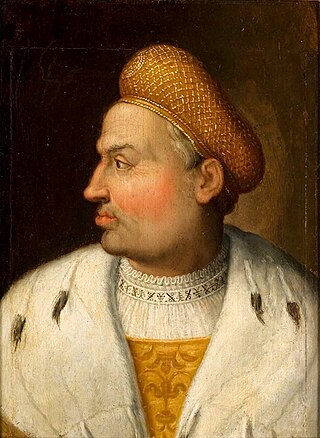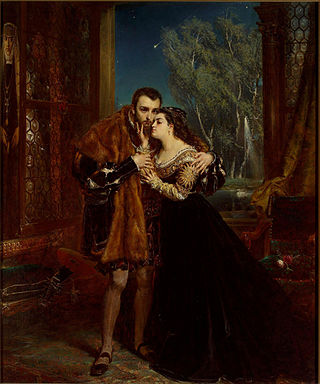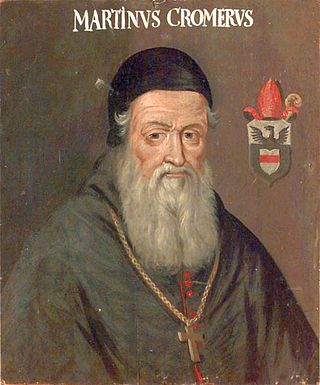
The Jagiellonian University is a public research university in Kraków, Poland. Founded in 1364 by King Casimir III the Great, it is the oldest university in Poland and the 13th oldest university in continuous operation in the world. It is regarded as Poland's most prestigious academic institution. The university has been viewed as a vanguard of Polish culture as well as a significant contributor to the intellectual heritage of Europe.

Sigismund II Augustus was King of Poland and Grand Duke of Lithuania, the son of Sigismund I the Old, whom Sigismund II succeeded in 1548. He was the first ruler of the Polish–Lithuanian Commonwealth and the last male monarch from the Jagiellonian dynasty.

Sigismund I the Old was King of Poland and Grand Duke of Lithuania from 1506 until his death in 1548. Sigismund I was a member of the Jagiellonian dynasty, the son of Casimir IV and younger brother of Kings John I Albert and Alexander I Jagiellon. He was nicknamed "the Old" in later historiography to distinguish him from his son and successor, Sigismund II Augustus. Before ascending to the Polish and Lithuanian thrones, he was Duke of Głogów from 1499, Duke of Opava from 1501, and governor of Silesia from 1504 on behalf of his brother, King Vladislaus II of Bohemia and Hungary.

Władysław III of Poland, also known as Ladislaus of Varna, was King of Poland and Supreme Duke of the Grand Duchy of Lithuania from 1434 as well as King of Hungary and Croatia from 1440 until his death at the Battle of Varna. He was the eldest son of Władysław II Jagiełło (Jogaila) and the Lithuanian noblewoman Sophia of Halshany.

The Polish Golden Age was the Renaissance period in Poland and the Grand Duchy of Lithuania, roughly corresponding to the period of rule of the King Sigismund I the Old (1506–1548) and his son, Sigismund II Augustus, the last of the Jagiellonian Dynasty monarchs, until his death in 1572. Some historians argue that the Polish Golden Age continued into the mid-17th century, when the Polish–Lithuanian Commonwealth was ravaged by the Khmelnytsky Uprising (1648–57) and by the Swedish and Russian invasion. During its Golden Age, the Commonwealth became one of the largest kingdoms of Europe, stretching from modern Estonia in the north to Moldavia in the east and Bohemia in the west.

Marcin Kromer was Prince-Bishop of Warmia (Ermland), a Polish cartographer, diplomat and historian in the Kingdom of Poland and later in the Polish–Lithuanian Commonwealth. He was a personal secretary to two Kings of Poland, Sigismund I the Old and Sigismund II Augustus.

Wincenty Kadłubek was a Polish Catholic prelate and professed Cistercian who served as the Bishop of Kraków from 1208 until his resignation in 1218. His episcopal mission was to reform the diocesan priests to ensure their holiness and invigorate the faithful and cultivate greater participation in ecclesial affairs on their part. Wincenty was much more than just a bishop; he was a leading scholar in Poland from the twelfth and thirteenth centuries. He was also a lawyer, historian, church reformer, monk, magister, and the father of Polish culture and national identity.

The Renaissance in Poland lasted from the late 15th to the late 16th century and is widely considered to have been the Golden Age of Polish culture. Ruled by the Jagiellonian dynasty, the Crown of the Kingdom of Poland actively participated in the broad European Renaissance. The multinational Polish state experienced a period of cultural growth thanks in part to a century without major wars, aside from conflicts in the sparsely-populated eastern and southern borderlands. The Reformation spread peacefully throughout the country, and living conditions improved, cities grew, and exports of agricultural products enriched the population, especially the nobility (szlachta), who gained dominance in the new political system of Golden Liberty.

Maciej Miechowita was a Polish renaissance scholar, professor of Jagiellonian University, historian, chronicler, geographer, medical doctor, alchemist, astrologer and canon in Kraków.

The Gesta principum Polonorum is the oldest known medieval chronicle documenting the history of Poland from the legendary times until 1113. Written in Latin by an anonymous author, it was most likely completed between 1112 and 1118, and its extant text is present in three manuscripts with two distinct traditions. Its anonymous author is traditionally called Gallus, a foreigner and outcast from an unknown country, who travelled to the Kingdom of Poland via Hungary. Gesta was commissioned by Poland's then ruler, Boleslaus III Wrymouth; Gallus expected a prize for his work, which he most likely received and of which he lived the rest of his life.
Lechites, also known as the Lechitic tribes, is a name given to certain West Slavic tribes who inhabited modern-day Poland and eastern Germany, and were speakers of the Lechitic languages. Distinct from the Czech–Slovak subgroup, they are the closest ancestors of ethnic Poles and of Pomeranians, Lusatians and Polabians.

Chronica seu originale regum et principum Poloniae, short name Chronica Polonorum, is a Latin history of Poland written by Wincenty Kadłubek between 1190 and 1208 CE. The work was probably commissioned by Casimir II of Poland. Consisting of four books, it describes Polish history.
Michał Twaróg of Bystrzyków was a Polish philosopher and theologian of the early 16th century.

The rule of the Jagiellonian dynasty in Poland between 1386 and 1572 spans the Late Middle Ages and the Early Modern Period in European history. The Lithuanian Grand Duke Jogaila founded the dynasty; his marriage to Queen Jadwiga of Poland in 1386 strengthened an ongoing Polish–Lithuanian union. The partnership brought vast territories controlled by the Grand Duchy of Lithuania into Poland's sphere of influence and proved beneficial for both the Polish and Lithuanian people, who coexisted and cooperated in one of the largest political entities in Europe for the next four centuries.

The Jagiellonian or Jagellonian dynasty, otherwise the Jagiellon dynasty, the House of Jagiellon, or simply the Jagiellons, was the name assumed by a cadet branch of the Lithuanian ducal dynasty of Gediminids upon reception by Jogaila, the Grand Duke of Lithuania, of baptism as Władysław in 1386, which paved the way to his ensuing marriage to the Queen Regnant Jadwiga of Poland, resulting in his ascension to the Crown of the Kingdom of Poland as Władysław II Jagiełło, and the effective promotion of his branch to a royal dynasty. The Jagiellons reigned in several European countries between the 14th and 16th centuries. Members of the dynasty were Kings of Poland (1386–1572), Grand Dukes of Lithuania, Kings of Hungary, and Kings of Bohemia and imperial electors (1471–1526).

The Wielkopolska Chronicle is an anonymous medieval chronicle describing supposed history of Poland from legendary times up to the year 1273. It was written in Latin at the end of the 13th or the beginning of the 14th century.
Chronica Polonorum or Cronica Polonorum may refer to:

Blessed Michał Giedroyć was a Lithuanian Roman Catholic noble and brother of the Canons Regular of the Penitence of the Blessed Martyrs. Giedroyć did not have any great accomplishments, but his life followed the Devotio moderna, a movement calling for genuine pious practices such as humility, obedience, and simplicity of life.

Lel and Polel are Polish divine twins, first mentioned by Maciej Miechowita in the 16th century where he presents them as equivalents of Castor and Pollux and the sons of the goddess Łada, the equivalent of Leda. There is no complete agreement about the authenticity of the cult of Lel and Polel.
















